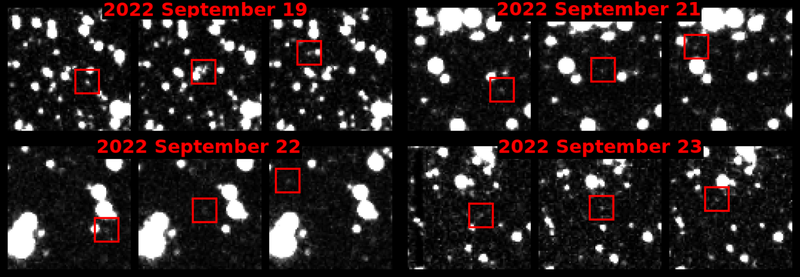An asteroid-hunting algorithm set to be implemented in the Vera C. Rubin Observatory’s 10-year survey spotted its first potentially hazardous asteroid, proving the algorithm’s capabilities in advance of the observatory’s opening.
The asteroid is 2022 SF289, a 600-foot-long space rock that’s currently about 4 astronomical units from Earth (that is, 4 times the distance Earth is from the Sun). But the asteroid swings by Earth on the opposite side of its orbit, classifying it as a potentially hazardous asteroid (or PHA).
As previously reported by Gizmodo, PHAs are a useful term for scientists but a poor one for the public. “Potentially hazardous” merely means there is some chance the object could impact Earth, and thus it is worth keeping an eye on. Last month, a 1,600-foot-long asteroid swung by Earth. As we wrote at the time:
“Potentially hazardous” asteroids are routine interlopers in Earth’s neck of the solar system. Despite their alarming name, they typically pose no threat to Earth. They are asteroids considered large enough to survive passing through our planet’s atmosphere and cause regional (or larger) damage on the ground, according to NASA’s Jet Propulsion Laboratory.
What’s significant about 2022 SF289 is not that it is hazardous, but that it was spotted by a new algorithm called HelioLinc3D. The recent asteroid spotting demonstrated that the algorithm can detect near-Earth asteroids with fewer observations than traditional methods. Because the Rubin Observatory is not yet up and running, HelioLinc3D was tested using the University of Hawaii’s ATLAS survey.
“By demonstrating the real-world effectiveness of the software that Rubin will use to look for thousands of yet-unknown potentially hazardous asteroids, the discovery of 2022 SF289 makes us all safer,” said Ari Heinze, a scientist and researcher at the Rubin Observatory and the University of Washington, and the principal developer of the new algorithm, in a university release.

The forthcoming observatory’s pièce de résistance is its 10-year Legacy Survey of Space and Time, which will image the night sky about once per week. The observatory sits high in Chile’s Atacama Desert, giving it clear views of space without much atmospheric distortion or light pollution.
The observatory was expected to open in 2022 but has been hampered by issues like the covid-19 pandemic. It is now slated to begin operations in 2025. The survey will rely on a 3.2-gigapixel (that’s a 3.2-billion-pixel) camera to do its imaging. At 5.5 feet (1.68 metres) across and 10 feet (3.05 metres) long, it is the largest digital camera ever built.
“The main deal is just get as much of the sky as quickly as possible and just repeatedly,” Steven Kahn, an astrophysicist and the director of the Rubin Observatory, told Gizmodo in 2021. “The simplest thing it can do is just say, ‘What’s changed? How has it changed?’ And we will do that up the wazoo.”
2022 SF289 was previously imaged three times on separate nights, but never four times in one night, which is necessary for the object to be classified as a Near Earth Object (NEO), according to the University of Washington.
“This is just a small taste of what to expect with the Rubin Observatory in less than two years, when HelioLinc3D will be discovering an object like this every night,” said Mario Jurić, a scientist at the Rubin Observatory, director of the DiRAC Institute, astronomer at the University of Washington, and leader of the team behind HelioLinc3D, in the same release.
“From HelioLinc3D to AI-assisted codes, the next decade of discovery will be a story of advancement in algorithms as much as in new, large, telescopes,” Jurić added. The Rubin Observatory is now expected to commence its observations in early 2025, though we’ll have to wait and see if that timeline sticks.
